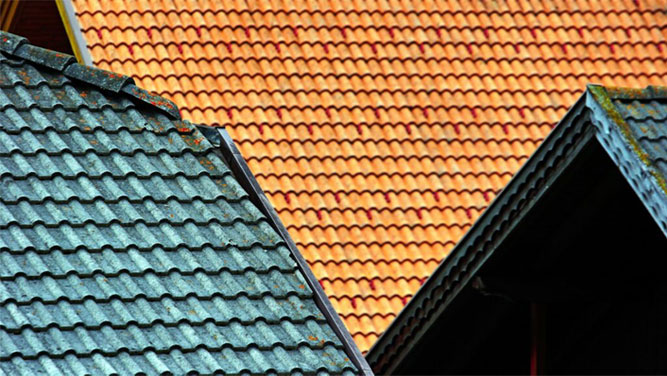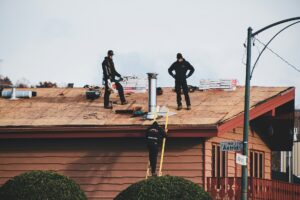Explore the Best Materials for Hot, Cold, Windy, or Humid Regions
Choosing the right roofing material isn’t just about aesthetics or budget; it’s also about how your roof copes with the weather outside. A roof that thrives in a temperate, low-humidity region might fare poorly in a hot, humid climate or a storm-prone coastal area. With extreme conditions becoming more common, selecting a roofing material suited to local challenges can save you money, stress, and frequent repairs.
In this guide, we’ll explore how varied climates—be they extremely hot, bitterly cold, perpetually wet, or prone to high winds—impact your roof’s performance. We’ll highlight which materials tend to excel in each environment, what vulnerabilities they might have, and why proper installation matters. By the end, you’ll have a solid grasp of how to pick a roof that not only looks good but also stands the test of time.
Why Climate Matters
Roofs do more than just shield you from rain. They also combat heat, fight off mold, endure high-speed winds, and handle fluctuating temperatures. In hot, sunny areas, for instance, certain materials can warp, fade, or crack if they aren’t built for extreme UV exposure. In cold, snowy regions, a flimsy roof risks collapsing under accumulated ice and snow. And near coastlines, salt-laden air can corrode metals or cause materials to degrade faster.
The key is to understand your local conditions and choose a roofing material that naturally aligns with them. Investing in a roof that’s well-tailored to your climate often means fewer repairs, a longer life cycle, and better energy efficiency. It also means less chance of waking up in the middle of the night because something went wrong on top of your house.
Hot and Dry Regions
High temperatures and relentless sunshine can stress roofing materials. Asphalt shingles might fade or curl if they’re not designed to handle heat. Clay or concrete tiles, on the other hand, are popular in desert climates because they reflect more sunlight and allow air to circulate underneath. Metal roofing also performs well, especially if you choose a reflective coating.
One thing to consider is that some hot regions experience big temperature drops at night—a phenomenon known as thermal shock. Materials like metal or tile handle these swings better than basic asphalt shingles. If you’re torn between options, you might look at “cool roof”–rated products that carry specialized coatings to reduce heat absorption and lower your cooling costs.
For more details on reflective materials and coatings, Energy.gov’s Cool Roof Guidance offers in-depth insights, including how these roofs can affect your home’s interior temperature.
Cold and Snowy Climates
In regions with brutal winters or frequent snowfall, roofs face different stresses. Accumulated snow adds weight, and the freeze-thaw cycle can warp materials or let ice dams form. Asphalt shingles designed for colder climates often feature thicker, more durable layers. Metal roofing is also a standout because snow slides off more easily, lessening the risk of roof collapse.
Slate or synthetic slate tiles are another strong contender for cold zones. True slate can last 70 years or more and withstands harsh winters if installed correctly, though it’s heavy and pricey. Synthetic slate offers a similar look at a reduced weight and cost. Regardless of your choice, make sure you have good ventilation and insulation to reduce ice dams. Inadequate attic airflow traps heat, which melts the underside of snow and lets water refreeze at the edges.
If you’d like details on winter-focused underlayment or specialized flashing, GAF’s Roofing Shingle & Underlayment Info is a good place to start.
High-Wind or Hurricane Zones
Areas prone to hurricanes or tornadoes require roofing materials that can handle powerful gusts and flying debris. Interlocking metal roofs are known for superior wind resistance if installed properly, often with wind ratings exceeding 140 mph. Concrete tiles can also work well in wind-prone regions, but they must be securely fastened to avoid becoming dangerous projectiles.
If you’re partial to asphalt shingles, look for those labeled “impact-resistant” or “Class 4.” They contain reinforced polymers or thicker layers to withstand hail and high winds. Just note that even the best-rated shingles can fail if the installer doesn’t use the right fastening techniques. Double-check your contractor’s familiarity with local codes and guidelines for wind mitigation.
For official guidelines on wind-resistant construction, FEMA’s Building Science Resources provide regularly updated best practices.
Wet, Humid, or Tropical Regions
If you live somewhere with year-round humidity, frequent rain, or tropical storms, your roof needs to keep moisture at bay. Metal roofing with corrosion-resistant finishes can stand up to constant dampness, especially if you’re near the coast and dealing with salty air. Clay and concrete tiles also do a fine job of keeping moisture out, though proper underlayment is vital.
Mold, algae, and moss are common headaches in wet climates. Many modern asphalt shingles include an algae-resistant coating, which helps minimize unsightly stains and reduces maintenance. Keeping gutters clean and trimming back overhanging branches also helps, as it reduces debris buildup that traps moisture. If humidity is intense, make sure your attic has adequate airflow and the underlayment is mildew-resistant.
For algae-resistant shingle options, CertainTeed’s Product Guide details lines infused with special biocides to discourage fungal growth.
Matching Material to Climate: A Quick Overview
While no single roof material is perfect for all conditions, some are known to excel under specific stresses:
- Metal: Durable, reflective, and good in heat or high winds. Can be noisy in heavy rain.
- Clay/Concrete Tile: Ideal for hot or humid areas, but heavy and sometimes fragile during installation.
- Asphalt Shingles: A versatile, cost-effective choice. Durability depends on the specific product; look for premium lines in extreme climates.
- Slate: Fantastic longevity for cold and snowy regions, but the weight and cost can be prohibitive. Synthetic slate offers a middle ground.
- Algae-Resistant Shingles: A strong pick in humid or wet climates prone to moss or mold buildup.
Installation Quality and Ventilation
Even the top-tier material can fail too soon if installed poorly or if attic ventilation is lacking. Adequate airflow reduces moisture buildup in hot, steamy weather and lessens the chance of ice dams in cold zones. It also helps regulate attic temperatures, extending the life of many shingles and tiles. Make sure you pick a contractor who knows local building codes inside and out.
It’s also vital to confirm that the underlayment, flashing, and fasteners are suited to your climate. In a windy area, you may need extra nails per shingle or specialized anchoring for tiles. In humid zones, mold-resistant underlayment is worth the extra cost. And if you’re going with slate or tile, confirm your home’s structure can support the added weight.
For a deeper exploration of attic ventilation and insulation best practices, the NRCA (National Roofing Contractors Association) has technical bulletins that address region-specific installations.
Energy Efficiency and Reflectivity
While most homeowners pick roofing based on durability, energy efficiency is also worth considering. In scorching climates, a “cool” roof with high solar reflectivity can lower your attic temps and reduce air-conditioning costs. Metal, light-colored asphalt, and tiles are strong contenders here. In cooler areas, insulation plays a bigger role than color, though some people do choose darker shingles to capture limited winter sun.
If your region swings between temperature extremes, balanced ventilation and good attic insulation can matter more than whether your roof is dark or light. A moderate approach—like a mid-tone shingle or a metal roof with a mid-range reflectivity—sometimes works best for places that see both hot summers and cold winters.
Lifespan vs. Upfront Cost
You might be tempted by the lower initial cost of standard asphalt shingles, and that’s understandable. However, consider the long view. A 20-year roof might be cheaper in the moment, but a more durable metal or tile roof could last 40 to 70 years, ultimately saving you from a second (or third) replacement. If you plan to stay in your home for decades, or if you want a higher resale value, it might be worth stretching your budget now.
Slate is the gold standard in many ways—some slate roofs last over a century—but the material and labor can be steep. Synthetic alternatives or premium asphalt lines can offer a middle ground in terms of cost, longevity, and style.
Budgeting and Unexpected Expenses
It’s smart to factor in possible extra costs. If your roof’s existing decking is rotted when old shingles come off, you may need new plywood. In coastal areas or hurricane zones, local codes might require special fasteners or high-wind-rated materials. And if you’re installing clay or concrete tile, you might need to reinforce the rafters.
Plan for at least a 10–15% buffer on top of any estimate, especially in older homes or places with unpredictable weather. HomeAdvisor’s Roofing Cost Guide updates regularly with real-world data from homeowners, which can help you form realistic expectations.
Maintenance Tips in Any Climate
While climate-specific needs vary, some upkeep basics apply across the board. An annual or biannual roof inspection lets you catch missing shingles, cracked tiles, or moss growth early. Clean gutters keep water away from roof edges and prevent moisture infiltration. If you see leaks or damp spots in your attic, don’t wait—delaying repairs can lead to mold, rot, or structural damage.
If you’re unsure how to structure a maintenance routine, Angi’s Roof Maintenance Checklist offers month-by-month suggestions tailored to the average U.S. homeowner.
Finding Your Climate-Friendly Roof
A roof should be more than a decoration for your home’s exterior—it’s your first line of defense against the elements. If you’re in a sun-scorched region, consider materials like clay tile or metal that reflect heat. In snowy climates, a heavier-grade asphalt or standing-seam metal can handle ice dams and heavy snowfall. For gusty, hurricane-prone areas, investigate wind-rated options like interlocking metal panels or Class 4 impact-resistant shingles. And in places with year-round moisture, algae-resistant shingles or properly coated metal stand a better chance of avoiding mold and corrosion.
The final step is ensuring high-quality installation and ventilation. Ask your roofing contractor about attic airflow, underlayment types, and how they address common climate-related problems. Don’t hesitate to get multiple opinions—especially if you live in a region with extreme conditions. By matching your roof to your climate, you’re setting yourself up for fewer repairs, lower energy bills, and a roof that’s ready to protect you through every season.




